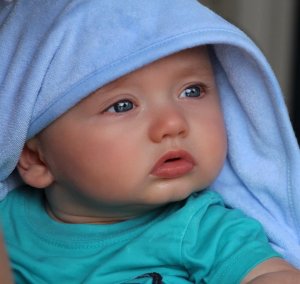Guest Blog by: Tracy Lepper, PhD, BCBA-D
Franciscan Missionaries of Our Lady University
 Many new parents may be experiencing heightened anxiety concerning their infant’s development during the COVID-19 pandemic due to social-distancing mandates decreasing access to social- and other- supports systems. One of these developmental milestones that is often a concern of parents is language acquisition; therefore, this blog is intended to provide new parents with some helpful tips to promote early language development.
Many new parents may be experiencing heightened anxiety concerning their infant’s development during the COVID-19 pandemic due to social-distancing mandates decreasing access to social- and other- supports systems. One of these developmental milestones that is often a concern of parents is language acquisition; therefore, this blog is intended to provide new parents with some helpful tips to promote early language development.
The emergence of adorable coos is one of the first observable signs of language acquisition, which is a complex social process. Coos are those infant-produced vowel-like “ooos and aahs” that give parents a warm fuzzy feeling every time they hear them. These “ooos and aahs” are produced when air passes through the vocal musculature and results in an auditory stimulus (a sound). Coos naturally engender loving responses from parents which can in turn increase coo production. In fact, one study of 3-8 month infants showed that when mothers responded to an infant’s sounds, the infants were more likely to produce similar sounds in the future. A follow-up to this research provides additional evidence that when adults respond immediately following an infant’s coos (rather than at random times), the infant’s vocalizations occur at more regular intervals. This is a clear example of the power of reinforcement, a basic principle of behavior analysis, in developing new behaviors.
Cooing is the Foundation for Complex Language
These vowel-like speech sounds commonly known as ‘cooing’ provide the basic building blocks for more advanced speech development. Frequent occurrences of these ever-so-stinking-cute building blocks means there is some ongoing behavior for the complex social process involved in language acquisition to capture. Capturing coos and other speech-like sounds requires those who hear these infant-vocal productions to respond differentially to the patterns and prosody of the vocalizations. In doing so the listener shapes “oos and aahs” into distinct sound patterns consistent with the speech sounds present in the infant’s environment. For instance, mothers may smile bigger and provide better tickles when their infant produces the short /o/ sound as opposed to the short /a/ sound, in hopes that “mom” is spoken before “dad.” Of course, dads and other listeners, can shape those adorable coos into words, too. An example of a father encouraging language development in his 19-month old son captured the internet’s attention last summer. Notice how Dad allows the toddler space to say something (anything!) and then encourages more by his reactions? That’s language training at its best!

Caregivers are not the only ones shaping these precious speech sounds, the infant is responding to these self-produced auditory stimuli as well. When tiny-tots self-produce sounds that resemble sounds they have heard spoken, it is rewarding for them, and they produce those sounds more often in the future (the term ‘parity’ has been used to describe this phenomenon). For the infants, self-production of sounds heard in the past may be equivalent to how you feel when you take the first bite of a cake after perfecting the recipe, or when you look at the display on the scale (even after eating your delectable cake) and it shows that you’ve met your weight-loss goal. It is that powerful, “Look, what I can do!” moment.
Some Tips for Encouraging Language Development
Although these initial sounds are not the be-all-end-all of language acquisition, it is enough to glean some helpful tips for parents who are concerned about early language development. These suggestions are loosely based on recommendations derived from research protocols that include other components that could likely impact outcomes.
 Talk. It doesn’t matter what you talk about to your infant: Just talk! Sing! Describe quantum mechanics! Whatever! This is about modeling and pairing speech sounds with loving events.
Talk. It doesn’t matter what you talk about to your infant: Just talk! Sing! Describe quantum mechanics! Whatever! This is about modeling and pairing speech sounds with loving events.- Celebrate sounds. Infants make many sounds, raspberries, coos, grunts, etc. Any sound is worth celebrating during infancy or for non-frequent vocalizers. You can celebrate these sounds by smiling and laughing after each infant-produced sound. If those reactions do not produce that “look what I just did” moment for your little one, try showing them their favorite toy, blowing bubbles, or a sip of their bottle, after they make a sound.
- Celebrate imitation of sounds. Infants may mimic a sound that you produce. If they do, throw a party! These imitative behaviors are an amazing achievement. Attempts to imitate should be celebrated. For example, if you model a sound and your infant opens their mouth, celebrate! If mouth opening is reliably occurring after your modeled sound, require a bit more. Continue to require a bit more, celebrating each step, until the sounds are exact matches.
- Jumpstart sounds. Some infants do not make a lot of sounds. If your little falls into this category, pick a sound to target. Vowel sounds and sounds that do not require use of the tongue (e.g., /b/, /m/, etc.) may be easier for infants to produce. When you do this, make sure your baby is looking at you, repeat the target sound a few times, and then deliver something they like. For example, before giving your infant their bottle you might say, “bah, bah, bah” then place the bottle in their mouth. This can be repeated before every drink throughout the day and can be done with other items. A perfect opportunity to do this is when your tot is reaching for a toy. At that point, gain attention, say the name of the toy a few times, and only then give the toy to your little one (if you are curious about the science that backs up this procedure, click here to read a peer-reviewed study on this very topic).
- Give them something to talk about. Parents need to be to adept at identifying
 the needs of their mini-mes. However, some parents are so skilled at interpreting their infant’s non-vocal and/or nonverbal cues and so responsive to those needs, they may begin to reply to those cues as if they were spoken, which decreases the need for the infant to use their emerging vocal skills. To give your little one something to talk about, just hold out a few seconds before you give them what they want. During those few seconds, wait for your tiny tot to use their words (or attempt) to request the item. If an attempt is made, delivery the item and celebrate! If no attempt is made, just incorporate the recommendations above in the Celebrating Imitation of Sounds and Jumpstarting Sounds.
the needs of their mini-mes. However, some parents are so skilled at interpreting their infant’s non-vocal and/or nonverbal cues and so responsive to those needs, they may begin to reply to those cues as if they were spoken, which decreases the need for the infant to use their emerging vocal skills. To give your little one something to talk about, just hold out a few seconds before you give them what they want. During those few seconds, wait for your tiny tot to use their words (or attempt) to request the item. If an attempt is made, delivery the item and celebrate! If no attempt is made, just incorporate the recommendations above in the Celebrating Imitation of Sounds and Jumpstarting Sounds.
Many new parents are likely to notice that they already do these things. Which is great! Keep it up and relax. Even if your social supports are not there to tell you, you are doing a great job! To find out more on early language development read, Let’s Talk, Baby.
 Dr. Tracy Lepper is Assistant Professor and ABA Program Director at Franciscan Missionaries of Our Lady University. Her clinical experiences include providing behavior analytic services to children and adults with autism spectrum disorder, dementia, traumatic brain injury, and juvenile sex offenders. Her research interests include assessment and treatment of non-socially mediated problem behavior, language acquisition, research methodologies, stimulus-preference assessments, and prompting strategies
Dr. Tracy Lepper is Assistant Professor and ABA Program Director at Franciscan Missionaries of Our Lady University. Her clinical experiences include providing behavior analytic services to children and adults with autism spectrum disorder, dementia, traumatic brain injury, and juvenile sex offenders. Her research interests include assessment and treatment of non-socially mediated problem behavior, language acquisition, research methodologies, stimulus-preference assessments, and prompting strategies
